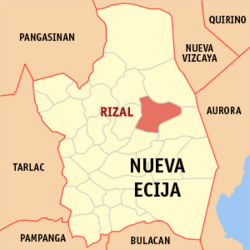Rizal, Nueva Ecija
| Rizal | ||
|---|---|---|
| Municipality | ||
|
Rizal Municipal Hall (Poblacion Sur) | ||
| ||
 Map of Nueva Ecija showing the location of Rizal | ||
.svg.png) Rizal Location within the Philippines | ||
| Coordinates: 15°41′N 121°10′E / 15.683°N 121.167°ECoordinates: 15°41′N 121°10′E / 15.683°N 121.167°E | ||
| Country | Philippines | |
| Region | Central Luzon (Region III) | |
| Province | Nueva Ecija | |
| District | 2nd District | |
| Founded | 1913 | |
| Barangays | 26 | |
| Government[1] | ||
| • Mayor | Rafaelito V. Andres | |
| • Vice Mayor | Dwight G. Mangapis | |
| Area[2] | ||
| • Total | 120.55 km2 (46.54 sq mi) | |
| Population (2010)[3] | ||
| • Total | 57,145 | |
| • Density | 470/km2 (1,200/sq mi) | |
| Time zone | PST (UTC+8) | |
| ZIP code | 3127 | |
| Dialing code | 44 | |
| Income class | 2nd class; rural | |
Rizal is a second class municipality in the province of Nueva Ecija, Philippines. According to the 2010 census, it had a population of 57,145 people.[3] Amyhan Fall, Mainit Hot Spring and Rizal dam are the top tourists spots everybody could visit.
Barangays
Rizal is politically subdivided into 26 barangays.[2]
- Agbannawag
- Aglipay
- Bicos
- Cabucbucan
- Calaocan District
- Canaan East
- Canaan West
- Casilagan
- Del Pilar
- Estrella
- General Luna
- Macapsing
- Maligaya
- Paco Roman
- Pag-asa
- Poblacion Central
- Poblacion East
- Poblacion Norte
- Poblacion Sur
- Poblacion West
- San Esteban
- San Gregorio
- Santa Monica
- Villa Labrador
- Villa Paraiso
History
Historically, two groups were known to have settled in the area. The main group consisted entirely of the pioneer-settlers who were Ilocanos, while others, who arrived later, were of different tribes with different dialects. They merged and formed a new neighborhood, originally called Bunobon after the bunobon seedlings that thrived in the soil. It became a sitio of Cabucbucan under the jurisdiction of Bongabon municipality.
In 1904, sitio Bunobon became a barrio called Nazareth. Because of the steady arrival of new settlers, a council of elders was formed. Selected as head was Apo Juliano Paraiso, one of the eldest within the group, who headed the request to the government to convert Nazareth into an independent town. Through the help of Governor Manuel Tinio and Assemblyman Isauro Gabaldon, the request of the elders was approved in 1908.
On December 26, 1912 Vice-Governor Newton signed the act and simultaneously issued a proclamation creating the town of RIZAL. The town was named after Doc. Jose Rizal. On January 1, 1913, Don Julian Paraiso took his oath as the first Alcalde of the Municipality. In 1917 and 1918, the Bureau of Land surveyed the Municipality into homestead and residential lots. In 1930, Barangay Paco Roman became barrio thru the leadership of the late Mr. Florentino Castelo, separating it from Barangay Estrella. Sometime in 1940, General Luna became a barrio of which the area was taken from barangay Canaan and in 1954 Villa Paraiso was created into a barrio separating it from Barangay Canaan and was named in honor of late Mayor Gaudencio V. Paraiso.
During World War II, Japanese Imperial forces occupies and entering the town in Rizal in 1942. In 1945, combined U.S. and Philippine Commonwealth ground troops including the local various recognized guerrillas and Hukbalahap Communist guerrillas liberated the town and defeated Japanese Imperial forces and ended the Second World War. After the war, many families started business and agricultural and farm lands.
In 1954, Rizal lost some of its territory when the barrios of San Felipe and San Alfonso were separated to form the town of Llanera along with some territory from Talavera and San Jose.[4]
In 1963, Villa Pascua was renamed Barangay Pag-asa which is a part of Barangay Agbanawag. In January 1968, Barangay Casilagan became a barrio thru Res. No. 2 of the Provincial Board on January 3, 1968, which was formerly a sitio of Canaan, which was bisected by the Bulalakay Creek, and it was divided into two barrios known as Canaan Este and Canaan Weste. On July 20, 1970, Sanggunian Panlalawigan passed Resolution No. 220 approving the creation of Barangay Maligaya in accordance with R.A. No. 3590, the area to be taken from the Barangay Bicos and on July 12, 1971 then the Provincial Board Resolution No. 231, Villa Labrador became a Barrio separating it to Villa Paraiso.
Demographics
| Population census of Rizal | ||
|---|---|---|
| Year | Pop. | ±% p.a. |
| 1990 | 38,970 | — |
| 1995 | 45,834 | +3.09% |
| 2000 | 48,166 | +1.07% |
| 2007 | 52,465 | +1.19% |
| 2010 | 57,145 | +3.16% |
| Source: National Statistics Office[3] | ||
References
- ↑ "Official City/Municipal 2013 Election Results". Intramuros, Manila, Philippines: Commission on Elections (COMELEC). 11 September 2013. Retrieved 21 October 2013.
- 1 2 "Province: Nueva Ecija". PSGC Interactive. Makati City, Philippines: National Statistical Coordination Board. Retrieved 21 October 2013.
- 1 2 3 "Total Population by Province, City, Municipality and Barangay: as of May 1, 2010" (PDF). 2010 Census of Population and Housing. National Statistics Office. Retrieved 2012-10-22.
- ↑ "An Act to Create the Municipality of Llanera in the Province of Nueva Ecija". LawPH.com. Retrieved 2011-04-11.
External links
| Wikimedia Commons has media related to Rizal, Nueva Ecija. |
- Philippine Standard Geographic Code
- Philippine Census Information
- Local Governance Performance Management System
 |
San Jose | Pantabangan |  | |
| Llanera | |
Bongabon | ||
| ||||
| | ||||
| Gen. Mamerto Natividad |
